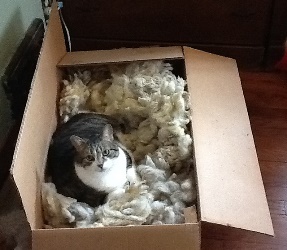My professional and crafting lives have collided—in a good way—since I joined Interweave in mid-January and moved to Colorado. Packing up my old studio has also helped me reevaluate certain priorities for a new room. Physical layout can make or break a working room. But perhaps the mental layout carries even more weight. So I wanted to write a series of posts on arranging these spaces before I move into a long-term project journal for the Spinning Daily community. Like most people, I do not enjoy packing up a living space and losing access to all my stuff for more than 24 hours. When it’s my textile studio (garment and accessory sewing, fiber prep, spinning, knitting, needlefelting, and a little weaving, plus storage for all these crafts), that displeasure increases and packing gets slower as I reminisce about each skein of yarn, fiber tool, sewing pattern that used to fit. Fortunately, friends came to the rescue; they basically dumped stuff into boxes for me and knew the difference between fleece and batts when labeling. Thanks, ladies—I owe you one! Pro tip for packing spinning wheels: cover the wheel with a plastic bag of some sort, set it in a wardrobe box, then fill up the empty space with fiber, yarn, fabric, and other soft things. All my wheels survived the trip unscathed and then the fiber was right there, ready to be stored. Unpacking is much more fun, especially after treating myself to a new desk for sewing machines and some new storage gear for the closet. Old furnishings now perform some different functions. One long, low table that used to live in my office houses drumcarder, combs, wool picker, blending board, and pressing/blocking equipment on its bottom shelf. The top shelf will stay clear for actually using all these gadgets. That’s my biggest mental adjustment. Spinning wheels also live in the studio until they’re needed for a specific project; then they move out to the living room so I can watch TV while I spin. I’ll talk more in a later post about how I match a particular wheel to a desired yarn. Finally, there are storage considerations. Since my current home is temporary, I didn’t want to unpack everything only to repack in a few months. But if inspiration hits, and suddenly I have to start a particular sweater or comb a particular fleece, materials have to be available. My cats also don’t need more encouragement to engage in this kind of behavior! So I’ve got marked boxes of fiber piled at the back of a closet, project kits for yarn and fabric in hanging shoe organizers, in clear plastic boxes, or on small shelves at the front. Current knitting projects live in bags hanging on the studio door, for easy access, and current spinning projects settle into baskets. This physical layout hopefully hit the right mix of convenience and easy repacking. My mental layout—reimagining some old ideas, jettisoning some unfinished projects that I abandoned ages ago, rethinking ways to use space—still has to catch up.
|



